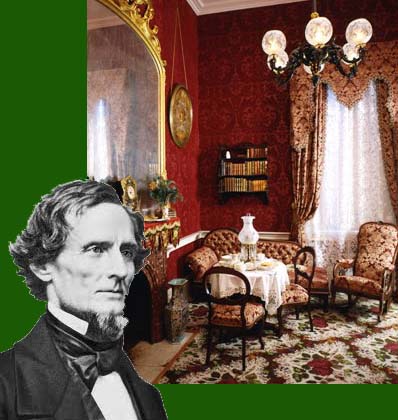| |
# |
Site |
Comments |
Photo |
Visits |
11 |
Hampton Roads /
Mariners' Museum
Newport News
Virginia

|
The
clash of the ironclads at Hampton Roads is among the Civil War's most
compelling stories. The South converted the captured steamer Merrimack to the ironclad Virginia at the Norfolk naval yard. On 8 Mar 1862, she sank two large wooden gunships. The next day the Union's innovative gunboat Monitor arrived, sparking the world's first battle between ironclads. The fight was indecisive as between them, but the Monitor saved the Union fleet. The Virginia withdrew and was later blown up by the South when they abandoned Norfolk on 9 May 1862. The Monitor was lost in a gale off Cape Hatteras on 31 Dec 1862.
The wreck of the Monitor was discovered in 1973; the anchor recovered in 1983; and the turret
and a gun in 2002. Preservation is underway at the Mariners' Museum
in Newport News, where a turret gun can be seen, visitors can walk
the deck of a full-scale Monitor replica, and experience
interactive exhibits. There are many artifacts to see, and hallway
walls are lined with period art of the battle. The actual site of the
clash can be seen while driving the Hampton Roads bridge tunnel
(Interstate 664), or by boat.
|
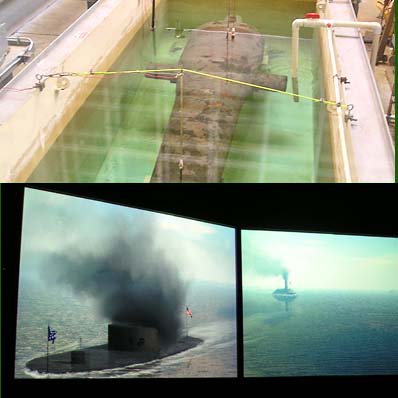 An original turret gun from the U.S. Monitor,
recovered from the Atlantic shipwreck in 2002, lies in a preserving
solution at the Maritime Museum, while a dramatic 360° recreation
of the "Battle of the Ironclads" is featured in the battle theater
(June 2009)
An original turret gun from the U.S. Monitor,
recovered from the Atlantic shipwreck in 2002, lies in a preserving
solution at the Maritime Museum, while a dramatic 360° recreation
of the "Battle of the Ironclads" is featured in the battle theater
(June 2009) |
June
2009 |
12 |
Ford's Theatre
Ford's Theatre National Historic Site, Lincoln Museum, and House where Lincoln Died
Washington D.C.
|
On
the night of 14 April 1865, just five days after Lee's surrender at
Appomattox, actor John Wilkes Booth shot President Abraham Lincoln at
Ford's Theatre during a performance of Our American Cousin.
The unconscious Lincoln was taken across the street to an upstairs
bedroom in the Peterson home, where he died early the next morning. It
was the tragic coda to America's monumental conflict.
Ford's
Theatre, purchased by the federal government in 1866, is still used for
theatrical productions, but Lincoln's box remains preserved as it was
that fateful day, as is the Peterson house (House where Lincoln Died)
across the street. An excellent Lincoln Museum is in the theatre
basement. During our most recent visit (June 2009) the theatre and
museum were undergoing renovations, so we must visit again to see the
current interpretation. The site is a powerful and poignant one to
visit.
|
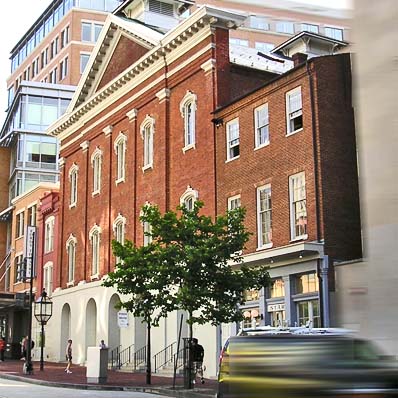 Ford's Theatre at 511 10th St., Washington, D.C. (June 2009)
Ford's Theatre at 511 10th St., Washington, D.C. (June 2009) |
June 1967,
Aug 1997,
June 2009 |
13 |
Museum of the Confederacy & Confederate White House
Richmond
Virginia
|
The
Museum of the Confederacy at 1201 E. Clay Street, Richmond, Virginia,
is right next door to the Confederate White House. Jefferson Davis and
his family resided there during the Civil War. The Museum is
spectacular, and each time I've visited it has taken at least a
half-day to view all the exhibits which cover the entire war. The
exhibits are superb and include many rare and evocative artifacts. One
must take a tour of the Confederate White House (shown at right in a
photo from the Internet) – it is lavishly decorated in Victorian
furnishings and very interesting. Given his dyspepsia (an old name for
acid reflux), he and wife Varina slept in a specially-made bed with a
45° upward angle at the head. They had six children here (two born
during the war).
Although not a battlefield,
this is the best museum in existence focused on the Civil War, and is
remarkably even-handed in its interpretation. Having the Confederate
White House next door just adds to the luster of this historic site.
|
|
June 1967,
Sep
1985,
Dec 1994 |
14 |
Petersburg
National Battlefield
Virginia

historic photo of Battery 8, Dimmock Line, on Petersburg battlefield
|
Petersburg
National Battlefield preserves a campaign, not a single battle. When
Gen. U.S. Grant moved south in spring 1984, he was met by Gen. R.E. Lee
in numerous battles discussed separately in this project (e.g., The
Wilderness, Spotsylvania, Cold Harbor). Blocked from taking Richmond
frontally, Grant chose to bypass it and conduct a siege at Petersburg,
cutting Richmond's supply line to the south. The siege took almost a
year -- June 1864 to late March 1865 -- but did end the war. Important
clashes during the siege included the Battle of the Crater (following
the dramatic exploding of an underground mine below rebel lines on 30
July 1864) and Ft. Stedman (24 Mar 1865).
The
tour route takes the visitor along the siege lines; alas, time
has softened the landscape and, for example, "The Crater" now looks
like a mild depression. During the summer, "Living History" exhibits
often enliven visits; we certainly were entranced by the enactment of a
Confederate cannon team during an August 1997 visit. In addition, the Civil War Trust has been acquiring additional land, and I suspect future visits will be improved by new interpretation and new sites. |
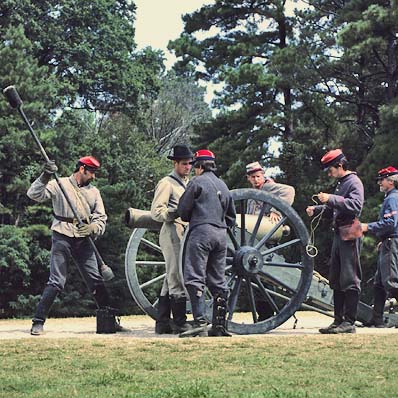 "Living History" at Ft. Stedman, Petersburg Battlefield, as re-enactors
"Living History" at Ft. Stedman, Petersburg Battlefield, as re-enactors
load and shoot a cannon as a Confederate battery team (Aug 1997) |
June 1967, Aug 1997 |
15 |
Wilsons Creek
Wilsons Creek National Battlefield
Missouri

|
In
1861, Confederate efforts to hold Missouri were supported by State Gov.
Jackson and Gens. McCullough and Price. Union Gen. Nathaniel Lyon
decided to attack combined Confederate forces camped at Wilsons Creek
in sw. Missouri. He planned a complicated assault that included an
attack on the Confederate rear by Gen. Franz Sigel. It was a daring
plan but much too complex for Union forces at this early stage of the
war. They were routed by rebel counter-attacks, and Gen. Lyon killed on
Oak Hill ("Bloody Hill") during the 10 Aug 1861 battle. The North would
not gain control of Missouri until the Battle of Pea Ridge in March
1862.
The battlefield is wonderfully preserved
as it was in 1861, in the "new style" without many rows of cannon or
monuments (except at the site of Lyon's death). The visitor center's
interpretive large-scale map of the battle strategy is excellent, and
the tour route through this large battlefield site is impressive for
its feel for the landscape.
|
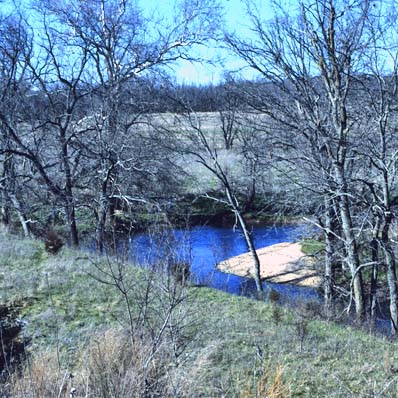 Wilsons Creek meanders through the rolling foothills of southwestern Missouri within the preserved battlefield (March 1997)
Wilsons Creek meanders through the rolling foothills of southwestern Missouri within the preserved battlefield (March 1997) |
Mar
1997 |
16 |
Fort Donelson
National Battlefield
Tennessee

|
U.S.
Grant's campaign to capture Tennessee in early 1862 was the Union's
first huge success. First, a combined river-boat & army operation
captured Ft. Henry on the Tennessee River on 6 Feb 1862 [the site is
today under a reservoir]. Then Grant marched overland and invested Ft.
Donelson on the Cumberland 12-16 Feb 1862. A rebel break-out attempt
was badly bungled, two southern generals slipped away at night (Floyd
& Pillow), leaving it to Grant's old friend Simon Buckner to
surrender the garrison. Grant answered Buckner's request for terms with
his famous "unconditional surrender" message, and captured 8000 rebel
soldiers.
This battlefield and the parapets of
the fort are well-maintained, and there is a spectacular view over the
Cumberland River. The Dover Hotel where the surrender took place is
preserved as a separate site. |
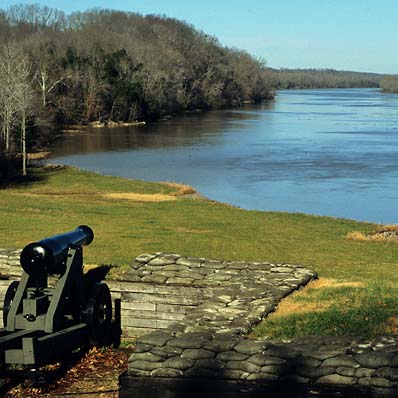
View of the Cumberland River from Confederate battery
at Ft. Donelson (Dec 2002) |
Dec 2002 |
17 |
Stones River
(Murfreesboro)
Stones River National Battlefield
Tennessee

|
After
the southern loss at Perryville in Oct 1862, Confederate Gen. Braxton
Bragg withdrew south to Murfreesboro. The Union Army of the Cumberland,
under Gen. W.E. Rosecrans (replacing Buell), followed. By the last
month of 1862, the two armies faced each other across Stones River.
Both commanders had the same plan of attack for the morning: feint with
their right and attack with their left. In executing these maneuvers,
the armies were still positioned facing each other at day's end, after
incredible and heroic fighting, but at a 90° angle from where they
had started. Bragg tried another attack on 2 Jan 1863, but it also
failed; Bragg withdrew to Chattanooga. There is debate as to which side
"won" the battle, but strategically it was a great Northern victory.
The
battlefield road winds through thick cedars and the critical points
are nicely preserved. Unfortunately, the battlefield was created much
too small in size and urban shopping malls and car dealerships confront
the visitor at the edges, detracting from the visit. |
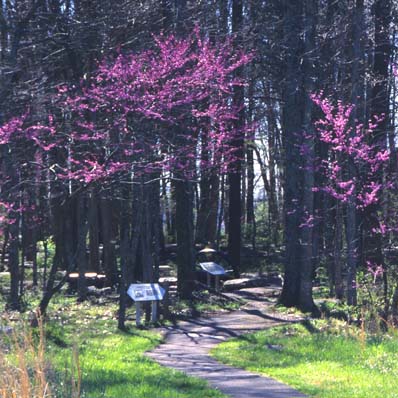
Blooming redbuds brighten a forest at the center of
Stones River battlefield (Mar 1997) |
June 1967,
Mar
1997 |
18 |
Seven Days Battle
Richmond National Battlefield, plus
Fair Oaks
Virginia

sign for Malvern Hill battlefield, the final day of the Seven Days
|
The Seven Days Battle was the culmination of Gen. George McClellan's effort to capture Richmond during his Peninsular Campaign in June 1862. Robert E. Lee took over from the injured "Joe" Johnston after Fair Oaks (Seven Pines), and attacked McClellan's army from 25 June-1 July, pushing the Yankees back from Richmond and to eventual withdrawal.
The sites are interpreted within Richmond National Battlefield, with varying degrees of success. depending on land preservation. "Living History" helps enliven visits in summer:
- Fair Oaks: a cemetery is now among the suburbs [not actually part of the "Seven Days"] with more land recently acquired
- Mechanicsville: little to see beyond roadside signs
- Beaver Dam Creek: nice small battlefield
- Gaines Mill: large important battle, good-sized battlefield
- Frasers Farm, Savage Station & White Oak Swamp: a few road signs on prior visit, but more land was been saved since then
- Malvern Hill: the site of main Confederate charge is preserved
This situation has been changing with the Civil War Trust's acquisition of a lot of battlefield land here. I hope much of it will be open and interpreted by the next time I get back to Richmond. A substantial acquisition at Gaines Mill should surely be intepreted by now.
|
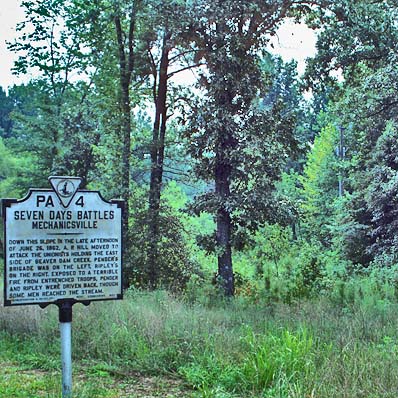 An old-style sign marks a site on the Mechanicsville battlefield,
An old-style sign marks a site on the Mechanicsville battlefield,
the first of the Seven Days' Battle (Aug 1997) |
June 1967, Aug 1997 |
19 |
First Manassas
(First Bull Run)
Manassas National Battlefield
Virginia

|
It is hard enough to preserve and interpret a 150+ year old battlefield for the public; it is almost impossible to interpret two 150-year old battles that were fought on essentially the same spot. It is inevitable that only one battle can be properly highlighted -- and the Park Service has chosen to emphasize First Manassas, on 21 July 1861, over Second Manassas in August 1862. At First Manassas ~ 60,000 men were involved (32K Confederate, 28K Union) which is less than half the ~124,000 soldiers engaged in Second Manassas. Yet, First Manassas it is much better known to the general public, and was the first major Civil War battle in the East. Many civilians came to watch the fight on that sunny July day in 1861. "Stonewall" Jackson got his moniker here.
First Manassas swirled around Henry Hill, and here the battle is very well-interpreted with a well-preserved Henry House, a statue of Thomas J. Jackson, and good walking trails. But alas, the rest of the battlefield is broken up into small pieces, as modern and very busy roads bisect the site. Heavy traffic often interferes with battlefield visits.
|
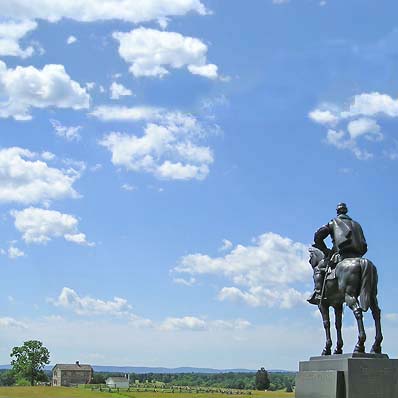 T.J. "Stonewall" Jackson statue looks towards the Henry House on Henry Hill, First Manassas (June 2009)
T.J. "Stonewall" Jackson statue looks towards the Henry House on Henry Hill, First Manassas (June 2009) |
June 1967,
Sep
1985,
June
2009 |
| 20 |
Mill Springs
(Fishing Creek or
Logan's Crossroads)
Mill Springs National
Monument
Kentucky

|
The battle of Mill Springs, on 19 January 1862, had a much greater impact than usual for a small battle (just ~10,000 men involved, 4.4K Union, 5.9K Confederate). This was because it was the first Union victory after the debacle at First Manassas. It ensured that Kentucky would stay with the Union. Abraham Lincoln had said in 1861 that “I think to lose Kentucky is nearly the same as to lose the whole game."
Confederate troops led by Brig. Gen. Felix Zollicoffer attacked Union forces at dawn on a miserably wet day. Union troops had just been reinforced by forces under Brig. Gen. George Thomas, who took charge after a long, muddy march. In the poor visibility of rain and gunsmoke, Zollicoffer, on horseback, approached Union infranty, mistakenly believing they were Confederates firing on their own men. Zollicoffer was shot and killed. Demoralized, rebel forces were pushed to the Cumberland River by Union counter-attacks.
I manage to get to eastern battlefields only every 5 years or so, but it was only after Congress created this National Monument that this site acquired land, and built a new and excellant visitor center. A driving tour was mapped on rural roads, and it was easy to follow the course of the battle all the way to Lake Cumberland (the river was dammed years ago). Our May visit was good for birds and butterflies.
|
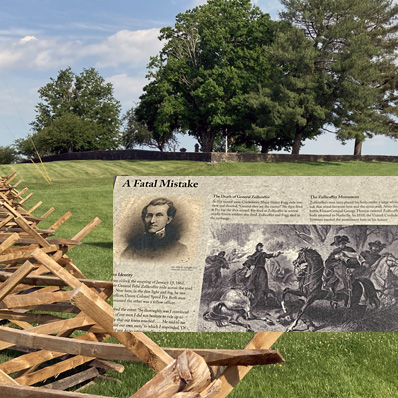 A collage of the Monument's interpretive sign and the site where A collage of the Monument's interpretive sign and the site where
Gen Zollicoffer died under the top left oak (May 2024).
Over the years local women placed flowers beneath "the Zollie tree"
on the anniversary of hte battle. The original oak finally fell; the park
service has re-planted an oak that is still growing today.
|
May 2024 |
|
RECOMMENDED BOOKS & MEDIA :
11. Battle of the Ironclads at Hampton Roads
- Books: William C. Davis' (1975) Duel between the First Ironclads may be the standard work, but needs maps and more photos. Ivan Musicant's (1995) Divided Waters: the Naval History of the Civil War gives extensive coverage of the creation of the ironclads and this
Hampton Roads fight. There was a lot more information available in the
Mariners' Museum, including extensive information on the recovery and
preservation of the Monitor.
12. Ford's Theatre, Washington, D.C.
- Media: The 2010 movie The Conspirator,
directed by Robert Redford and starring Robin Wright Penn, Tom
Wilkinson, and Kevin Kline, focuses on the trial of Mary Surratt for
conspiracy in Booth's plot to assassinate Abraham Lincoln. As of this
writing, I have not yet seen the movie and will not prejudge it; it
could be fair and compelling. Unfortunately, promotional clips for the
movie suggest she was innocent [Mary Surratt certainly knew of Booth's
plot of kidnap Lincoln, and was likely complicit in the murder plot.]
- Books:
Over the years I've read a number of books on the Lincoln
assassination, but most impressive so far is Edward Steers, Jr.'s
(2001) Blood on the Moon: The Assassination of Abraham Lincoln,
which covers the entire Booth plot, the question of guilt or innocence
of both Dr. Samuel Mudd and Mary Surratt (both were in on Booth's
original plot to kidnap Lincoln), and the various attempts to rewrite
history in later years.
13. Museum of the Confederacy & Confederate White House, Richmond
- Books: William C. Davis' (1991) Jefferson Davis: the Man and his Hour: a Biography is an excellent introduction to the Confederate president, and, of
course, emphasizes primarily his years living in the Confederate White
House. Davis' (1996) The Cause Lost: Myths and Realities of the Confederacy make some fair points about nation-building.
14. The Petersburg Campaign
- Books:
I don't yet have a book focused on Petersburg; in truth, I am waiting
to see if Gordon Rhea writes it as the next in his series on Grant's
1864 campaign (I don't know whether or not he is working on it). In the
meantime, Chris Calkins' (1997) The Appomattox Campaign: March 29-April 9, 1865 covers the latter battles in 1865
15. Battle of Wilsons Creek
- Books: There are two excellent books: William R. Brooksher's (1995) Bloody Hill: the Civil War Battle of Wilson's Creek
is a lively read and has glossy photos, but could use better maps.
William Garrett Piston & Richard W. Hatcher III's (2000) Wilson's Creek: the Second Battle of the Civil War and the Men Who Fought It has
some decent maps and has a bit different approach to battle history,
emphasizing specific men in the fight through their letters, but that
does not distract from the main campaign history.
- In
addition, on a personal note, I grew up along the shores of Clear Lake,
Lake County, California. When you drive to Lakeport, the county seat,
up the east side, you pass a small marker to "Bloody Island" (now a
hill in farmland, so sometimes calls "Bloody Hill") where a massacre of
local Native Americans occurred on 15 May 1850. Commanding the U.S.
dragoons that massacred men, women, and children: then-Captain
Nathanial Lyon. Lyon would meet his own demise at "Bloody Hill" at
Wilsons Creek; see Christopher Phillips' (1990) Damned Yankee: the Life of General Nathaniel Lyon, pp. 66-69.
16. Battles of Ft. Henry & Ft. Donelson
- Books: Benjamin Franklin Cooling's (1987) Forts Henry and Donelson: The Key to the Confederate Heartland is a first-rate account of this campaign, and has maps and period photos scattered throughout. Bruce Catton's (1960) Grant Moves South
is still a classic history of Grant's entire 1861-1863 western
campaign, while Thomas L. Connelly's (1967, 1971) two-volume history of
the Army of Tennessee [Army of the Heartland, Autumn of Glory] is a fine overview of the entire war in Tennessee & Kentucky from the Confederate perspective.
17. Battle of Stones River
- Books:
There are two excellent battle studies: James Lee McDonough's (1980) Stones
River: Bloody Winter in Tennessee and Peter Cozzens' (1990) No Better Place
to Die: the Battle of Stones River. Each is similar in length (~220
pages) and each has maps, photos, or artwork. Cozzens is foot-noted;
McDonough is not but was an esteemed history professor. I've read both
at different times and been impressed, and cannot say I prefer one or
the other. In addition, the early Thomas L. Connelly's (1967, 1971)
two-volume history of the Army of Tennessee [Army of the Heartland, Autumn of Glory] has an overview of the entire war in Tennessee & Kentucky from the Confederate perspective.
18. The Peninsular Campaign: the Seven Days Battle
- Books: Stephen Sears' (1992) To the Gates of Richmond: the Peninsula Campaign was just fine, with maps and plenty of period photos. I also very much enjoyed the variety of historian essays in editor Gary W. Gallagher's (2000) The Richmond Campaign of 1862: The Peninsula and the Seven Days.
19. Battle of First Manassas (First Bull Run)
- Media: The 2003 movie Gods & Generals, starring Stephen Lang (as Jackson), Robert Duvall (as Lee), and Jeff Daniels (as Chamberlain) is uneven and at some points exasperating, but Lang's portrayal of "Stonewall" Jackson was Oscar-worthy, and the re-creation of First Manassas pretty darn good. A longer review of this movie is under Chancellorsville, below.
- Books: William C. Davis' (1977) Battle at Bull Run is a standard, and has some period photos, but now seems somewhat dated.
20. Battles of Mill Springs
- Books: Stuart W. Sanders' (2013) 130-page paperback The Battle of Mill Springs, Kentucky, in the Civil War Sesquicentiennial Series, does an excellent job on this very early battle that help determine the direction of the War in Tennessee and Kentucky. Lots of historical photos and a map.
|
or the choices via links at right:
|
|
|
|
|



